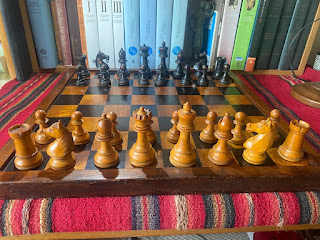How Old? Dating Antique Chess Sets with National Master Jon Crumiller
Introduction:
For the June episode of the Chess Collector Hangout, a video podcast by the Chess Collective, I engaged in a fascinating conversation with National Master John Miller, an esteemed chess collector and player. With over 50 years of experience and an extensive knowledge of the chess world, John is a true gem in the community. From his remarkable achievements as a player to his passion for collecting antique chess sets, this conversation offers profound insights into the intriguing realm of chess collectors and players.
 |
| Calvert Chess Set from The Jon Crumiller Collection (Courtesy of J. Crumiller) |
Unveiling John Miller's Chess Journey:
Meet John Miller, fondly known as the "Forest Gump of Chess," who has dedicated his life to the game for more than half a century. John's journey began with a victory in the Delaware state championship in 1976, leading him to attain the title of National Master in 2001. His list of accomplishments is impressive, having played alongside greats like Gary Kasparov and even achieving a draw with Magnus Carlsen in a simultaneous exhibition in New York City. But it is his passion for collecting antique chess sets that truly sets him apart.
The Beginning of a Collection:
Back in 2002, John stumbled upon an antique Jaques chess set on eBay, which sparked his interest in collecting. Little did he know that this encounter would mark the beginning of an incredible journey. Enchanted by the beauty of the 3.5-inch set, he won the bid and became captivated by the world of antique chess sets. This initial discovery led him to uncover more Jaques sets and explore other fascinating styles, including French, German, and Islamic patterns. The allure of these unique sets expanded his collection beyond functional playing sets, embracing ornamental display pieces.
 |
| Jon's 1st Jaques Chess Set (Courtesy of J. Crumiller) |
From Player to Collector:
Although John initially identified himself as a chess player, his growing collection eventually made him realize his true calling as a collector. As his home adorned with sets from different eras and styles, he embraced his role as a custodian of chess history. John's fascination with the history and provenance of chess sets, especially those originating from London, led him to auctions and helped him build a network of trusted collectors and dealers.
Authenticating Chess Sets:
Authenticating chess sets plays a crucial role in the collecting process, and John highlights the importance of trustworthy dealers who offer fair prices. As a collector, he embarked on a catalog project to understand the value of different sets, sharing this knowledge with the chess collecting community. Expert inspections and consensus opinions are vital in determining a set's authenticity, especially when restoration or replacement pieces are involved. Maintaining transparency regarding any restorations or replacements is essential for preserving the integrity of a set's history.
John Miller's Unique Focus:
While many collectors specialize in specific types of sets, John's collection spans a broader spectrum. In addition to antique chess sets, he holds a keen interest in antiquarian chess books, prints, magazines, and autographs. His collection can be defined by the intersection of two words: chess and antique. Seeking out one-of-a-kind antique chess sets has become a particular passion for John as he aims to acquire the finest examples of every type.
Misinformation in Chess Collecting:
Unfortunately, the world of chess collecting is not immune to misinformation. One prominent example is the existence of books, like the one by Alexander Hammond, that were considered authoritative sources on antique chess sets. However, further examination has revealed a substantial amount of incorrect information within these works. Some sets have been misidentified, and authors like Alexander Hammond have been found to fabricate stories or manipulate dating to increase the value of their own sets.
For chess collectors, understanding the origins of chess sets is crucial. While some sets may bear stamps or markings that provide valuable information, many others lack such identifiers, posing a challenge in identifying the maker, origin, and age of these sets. However, an avid chess collector took matters into their own hands and embarked on an extensive research project to uncover the truth.
The London Directory Project:
Recognizing the potential of trade directories as a valuable resource, this dedicated chess enthusiast meticulously collected trade directories, particularly London's post office directory, spanning the 18th to the 19th century. These directories provided comprehensive lists of chess manufacturers, retailers, and their respective years of operation. By compiling this data, the chess collector created a database of chess-related entries, forming a detailed timeline of chess set production and sales in London.
Unveiling the Chess Set Manufacturers:
Through this painstaking research, the chess collector shed light on the manufacturing history of chess sets in London. The database revealed intriguing patterns and connections among different manufacturers. For instance, it became apparent that William Lund, a renowned chess set maker, had apprenticed under Calvert, another prominent figure in the industry. Lund's patterns were traced back to Calvert, indicating a clear influence and evolution of design. Moreover, the research disproved the claim that Charles Hastilow, believed to be a dentist and not a chess set maker, actually had a presence in the chess set manufacturing industry.
Insights and Findings:
The London Directory Project provided invaluable insights into the chess set manufacturing landscape of London. Collectors and enthusiasts could now identify contemporaries, track changes in business locations, and even narrow down the dating of chess sets to specific years or within a short time frame. Additionally, the project highlighted the importance of examining knight heads, often intricately carved, as they can serve as key indicators for estimating the age of a chess set.
Accessing the Research:
While the chess collector may not be actively expanding the project, they have made their research available for others to explore. The database and findings can be accessed and downloaded from chessreference.com projects, offering a valuable resource for those interested in the history and origins of chess sets.
To access the interview and view Jon's Collection please see the video link below:



Comments
Post a Comment